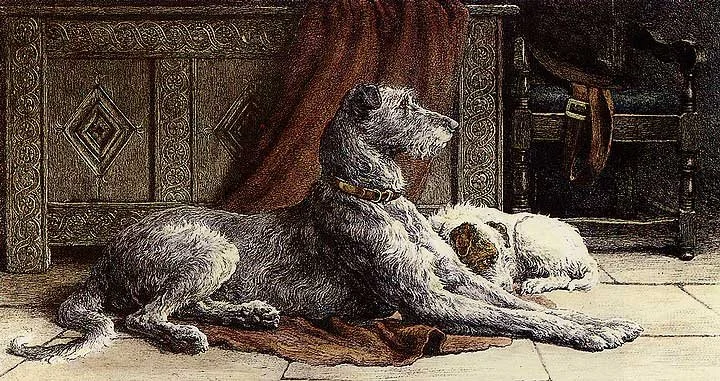
Irish Wolfhound History
The Irish Wolfhound is a breed of domestic dog that originated in Ireland. These dogs were originally used for hunting wolves and were known for their great size, strength, and courage. The history of the Irish Wolfhound can be traced back to ancient times. The earliest records of the breed date back to 391 AD, when the Roman Consul, Quintus Aurelius Symmachus, wrote a letter to the Roman Emperor, Theodosius, describing the "large and mighty" dogs of Ireland that were used for hunting wolves. These dogs were known as Cú Faoil, which means "Irish Hound" in Gaelic.
According to the Irish Wolfhound Club of America, the breed is believed to have been present in Ireland for over 2,000 years, with references to the breed in Irish literature and legend. The breed was highly prized by Irish kings and nobles, and were often given as gifts to foreign rulers. They were also used as war dogs in battles. The breed was known for its great size, strength, and courage and was valued for its ability to hunt large game, including wolves and deer.
The Irish conquered Scotland centuries ago and took their dogs with them. It may be said that the Irish and Scottish Hounds were really two strains of the same breed, altered by circumstances, use, and environment. Of the two, the Irish Hounds were probably the older, with the Scottish claiming the more direct descent. They have been distinct since the twelfth century.
By 1800 the old race was thinning out and comments regarding "the last of the race" were to be heard. There existed, indeed, three or four strains whose owners claimed for them the genuine Irish Wolfdog blood.
In 1841 H.D. Richardson wrote an article on the breed for an Irish journal and illustrated it. He was tremendously enthusiastic and set out to prove that despite claims to the contrary, the Irish Wolfhound was still to be found in Ireland. He collected and continued the breed and handed down not only the actual tradition but the actual strains to Sir John Power of Kilfane, Sir John and Mr. Baker of Ballytobin, and Mr. Mahoney of Dromore.
It was from these strains that Captain George Augustus Graham of Rednock, Dursley, secured specimens and by judicious outcrosses, chiefly with the Scottish Deerhound, sought to rehabilitate the breed. He kept up a constant inquiry for whatever animals could show a descent from the right Irish fore-bearers.
Sir John Power and Mr. Baker were breeding from 1842 to 1873. The Kilfane strain came directly from the Richardson dogs and if it is true that these possessed the ancient ancestry, then the breed never became entirely extinct. Captain Graham fully believed in the authentic antiquity of these strains, and "in their day," these men, who said they had some of the true blood, were known as gentlemen of integrity. Had their beliefs been false, it could easily have been established then, and they proven guilty of misrepresentation. Therefore, it is undoubtedly true that the breed was not extinct in 1800, but that a remnant survived.
Irish Wolfhounds were originally bred for hunting and are known for their great speed and endurance. They are also known to be very affectionate and gentle with their family and other pets. They are a great companion for children and adults alike. According to the Irish Wolfhound Club of America, the breed is highly adaptable and can thrive in a variety of living situations, from city apartments to rural farms.
In recent years, the Irish Wolfhound has become a popular show dog and is often seen at dog shows around the country. They have also been used as therapy dogs, as their gentle nature makes them well-suited for this work. According to the AKC, the Irish Wolfhound is a versatile breed that excels in many areas, from conformation and obedience to agility and therapy work.
Source:
Irish Wolfhound Club of America



